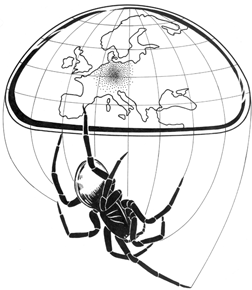Verbreitung und ökologische Charakterisierung der Kugelspinne Theridion hemerobium Simon, 1914 (Araneae: Theridiidae) in Europa
Distribution and ecological characterization of Theridion hemerobium Simon, 1914 (Araneae: Theridiidae) in Europe
ecology
Abstract
Distribution and ecological characterization of Theridion hemerobium Simon, 1914 (Araneae: Theridiidae) in Europe
Beobachtungen zur Stabilimentvariabilität bei adulten Weibchen der Wespenspinne (Argiope bruennichi) im Kreis Siegen-Wittgenstein (NRW)
Stabilimentum variability in the webs of adult female Argiope bruennichi
Germany, spider
Abstract
Stabilimentum variability in the webs of adult female Argiope bruennichi
Epigeic spiders of the pastures of northern Wielkopolska
Epigeic spiders of the pastures of northern Wielkopolska
epigeic spiders, pasture, community and species ecology, Poland
Abstract
The fauna of epigeic spiders (Araneae) occurring on three different types of pastures in northern Wielkopolska was analysed. Studies were conducted from May 1992 to October 1993. The 18,995 specimens collected were classified as belonging to 137 species and 17 families. The family Linyphiidae proved the richest in species while Lycosidae was the most abundantly in terms of number of specimens. Zoocenological analysis of spider communities showed their differentiation testifying to differences in the sites studied. The dominants were: 1) Osowo Stare (Site 1): Pardosa palustris, 2) Sycyn Dolny (Site 2): Xerolycosa miniata, P. palustris, Xysticus kochi, 3) Braczewo (Site 3): Erigone dentipalpis, P. palustris. Seasonal changes of dominance of the species at each site were established. A comparison of changes of the species’ dominances in the years 1992 and 1993 disclosed similar values of the individual dominance coefficient at the sites in Osowo Stare and Braczewo. This result indicates the occurrence of the process of stabilization of these biocenoses and a tendency to equilibrium in the environment. The least stable proved to be the site at Sycyn Dolny. Analysis of the seasonal dynamics of epigeic spider communities was also made by determining the mean number of species at each site in the two years of study. The highest number of species was noted in spring. It is interesting to note the appearance of species which are rare or very rare in Poland such as: Lepthyphantes insignis, Ostearius melanopygius, Enoplognatha mordax and Enoplognatha oelandica.
Die epigäische Spinnenfauna (Araneae) anthropogener Kleinflächen im Universitätsgebiet der Philipps-Universität auf den Lahnbergen bei Marburg
Epigaeic spiders (Araneae) of small man-made habitats on the Lahnberge Campus of the Philipps-University Marburg (Hesse, Germany)
Araneae, spider, traffic island, gravel roof, courtyard, man-made habitat, urban ecology, Hesse, Germany
Abstract
During May and June 1994, 45 pitfall traps were exposed in three types of small, urban habitats: traffic islands, flat gravel roofs and courtyards ranging from 65 to 1.800m2. The three habitat types differ in their exposure to sun and wind creating microclimatic conditions similar to a variety of natural habitats, i.e. grassland, rocky outcrops and forests. In total, 2.163 spiders (147 juveniles) were caught, belonging to 61 species in 16 families. A cluster analysis showed distinctively different spider assemblages for the three habitat types. Traffic islands are inhabited by a typical openland community. Dominating species are Alopecosa pulverulenta, Pardosa pullata and Pachygnatha degeeri. Gravel roofs show high numbers of salticids, in particular Euophrys lanigera. Courtyards lack dominant species and show a high number of species naturally occurring in forest habitats. The activity density on the gravel roofs and in the courtyards does not appear to be high enough to support stable populations.
Web damage during prey capture in Hyptiotes paradoxus (C.L. Koch 1834) (Uloboridae)
Web damage during prey capture in Hyptiotes paradoxus (C.L. Koch 1834) (Uloboridae)
Araneae; triangle spider; prey capture; meme
Abstract
H. paradoxus - well known for its characteristic triangular web - has frequently been described to always completely collapse its web when catching prey. The aim of the present article is to show that this is not the case, and to discuss how the myth of the obligate complete collapse of the web has arisen and why it survived so well.
Feuchtigkeits- und Belichtungspräferenzen bei Spinnen – ein Vergleich von zwei Klassifizierungssystemen
Moisture and light preferences of spiders – a comparison of two classification systems
Araneae; ecological groups; moisture; light
Abstract
Two classification systems (Martin 1991 and Maurer & Hänggi 1990) designed to describe spider preferences for certain moisture and light conditions are compared. Martin’s (1991) method tends to indicate (strong) preference. This is probably attributable to specific properties of Martin’s index.
Spinnen (Arachnida: Araneae) von Weinbergen und Weinbergsbrachen am Mittelrhein (Rheinland-Pfalz: Boppard, Oberwesel)
Spiders (Arachnida: Araneae) from vineyards and vineyard fallows along the Middle-Rhine area (Germany: Rheinland-Pfalz: Boppard, Oberwesel)
Araneae vineyards; Mittelrhein; Germany; faunistics
Abstract
56 spider species have been recorded in a 4-hours-fieldtrip. Twelve of them are endangered according to the red data book for spiders in Germany. Some interesting species are mentioned with comments on their habitat preference and distribution limits. Figures of two species (Theridion nigrovariegatum, Dipoena erythropus) are given because of variation in their genitalia.
Zwei für Deutschland neue Spinnenarten (Araneae): Enoplognatha serratosignata (L. Koch) (Theridiidae) und Cheiracanthium gratum Kulczynski (Clubionidae)
Enoplognatha serratosignata (L. Koch 1879) (Theridiidae) and Cheiracanthium gratum Kulczynski 1897 (Clubionidae) are recorded for Germany for the first time
Araneae; dune areas; Germany; first records
Abstract
C. gratum is not regarded as a synonym of C. angulitarse Simon 1876, and is revalidated. Both sexes are described, the female is described for the first time.
Selten nachgewiesene Spinnenarten aus Deutschland (Arachnida: Araneae)
Rarely collected spider species from Germany (Arachnida: Araneae)
faunistics; Germany; Araneae
Abstract
Some interesting records collected from 1990 to 1999 are reported. First records of Holocnemus pluchei for Rheinland-Pfalz and Baden-Württemberg and of Uloborus plumipes for Hessen and Schleswig-Holstein are listed. The occurrence of Heteropoda venatoria in Germany is confirmed by recent records in warmhouses in Berlin. Pardosa saturatior is collected from the Bavarian part of the Alps (National Park Berchtesgaden). Information on biology and taxonomy of Pardosa saturatior, Holocnemus pluchei and Heteropoda venatoria are given.


